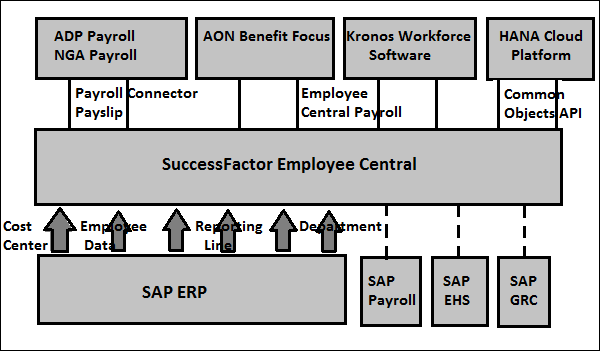Let’s dive into the world of SAP SuccessFactors Employee Central Integration! Whether you’re new to HR systems or just starting with SAP, I’ll walk you through this in a simple, beginner-friendly way. Imagine Employee Central as the hub where all HR and business processes come together—connecting employees, payroll, benefits, and enterprise systems seamlessly. Sounds exciting? Let’s break it down step by step.
What is Employee Central Integration?
In simple terms, Employee Central is like the brain of your HR operations. It doesn’t work in isolation—it communicates with other systems (both SAP and non-SAP) to ensure data flows smoothly. This integration eliminates manual data entry, reduces errors, and makes processes like payroll, attendance tracking, and reporting effortless.
Think of it as your smartphone syncing with apps like email, calendar, and fitness trackers—it keeps everything connected and up-to-date.
How Does Employee Central Integration Work?
Here’s how Employee Central connects with different systems:

1. SAP ERP Integration: The Backbone of Data Sharing
SAP ERP is like the foundation of many business operations. Employee Central works closely with it to manage:
- Cost Center Mapping: Every cost related to employees (like salaries, benefits, or training) is linked to cost centers, ensuring accurate financial tracking.
- Employee Data Syncing: Employee details like names, IDs, job roles, and contact info are shared between systems to avoid duplication.
- Reporting Lines: Who reports to whom? This critical hierarchy info is synchronized to ensure workflows and approvals happen smoothly.
- Department Assignments: Employees are assigned to specific departments within Employee Central, and this data flows into SAP ERP for better organization.
2. Payroll and Benefits Integration: Simplifying Employee Compensation
Payroll can be a nightmare if systems don’t talk to each other, right? Luckily, Employee Central integrates payroll and benefits like a pro:
- Third-Party Payroll Systems: If your company uses tools like ADP Payroll or NGA Payroll, Employee Central connects through a “connector” to send employee details, process salaries, and generate payslips.
- Employee Central Payroll: This cloud-based payroll system is directly tied to Employee Central, managing salaries, taxes, and deductions for employees across different countries.
- Benefit Tools: Platforms like AON Benefit Focus are integrated, allowing employees to view, choose, and manage their benefits—like health insurance or retirement plans—all in one place.
3. Integration with Time and Attendance Systems
Have you heard of Kronos Workforce Software? Employee Central integrates with it to track employee attendance, leaves, and overtime. This data is then shared with payroll systems to ensure employees get paid correctly.
4. Collaboration with SAP Ecosystem
Here’s where things get interesting! Employee Central doesn’t just stick to HR—it’s part of a larger SAP family, working with tools like:
- SAP Payroll: Handles payroll where Employee Central Payroll isn’t available.
- SAP EHS (Environment, Health, and Safety): Ensures workplace safety compliance using employee data.
- SAP GRC (Governance, Risk, and Compliance): Helps monitor compliance and reduce risks by analyzing workforce information.
5. HANA Cloud Platform Integration
Imagine Employee Central using APIs (Application Programming Interfaces) to connect to the SAP HANA Cloud Platform. This integration allows it to communicate with other cloud systems and share data for tasks like reporting and decision-making.
Why is Employee Central Integration Important?
Now you might wonder—why does all this integration even matter? Here’s why it’s a game-changer:
- No More Manual Work: Once everything is connected, data automatically flows between systems, saving time and reducing errors.
- Real-Time Updates: Changes made in one system (like a promotion or salary update) are instantly reflected in others.
- Global Compliance: For companies with offices worldwide, integration ensures compliance with local laws and regulations.
- Enhanced Efficiency: HR teams spend less time on admin tasks and more on strategic initiatives like employee engagement.
- Better Decision-Making: With integrated analytics, leaders can make informed decisions about workforce planning and costs.
Let’s Sum It Up
Employee Central integration might sound complex, but it’s like having a super-efficient assistant that keeps all your HR systems in sync. Whether it’s payroll, attendance tracking, or organizational hierarchy, everything works together like a well-oiled machine.
As a beginner, all you need to know is this: Employee Central is the glue that connects HR processes with the rest of the business. And the best part? You don’t need to worry about messy spreadsheets or mismatched data anymore!
